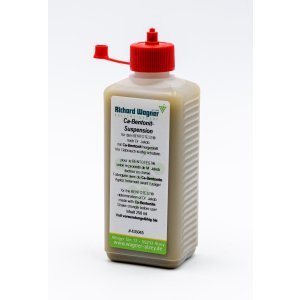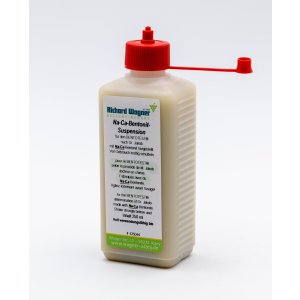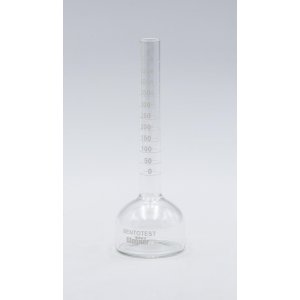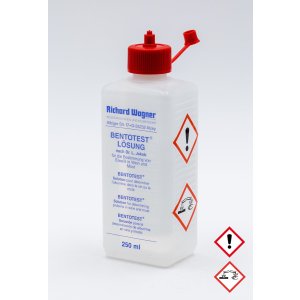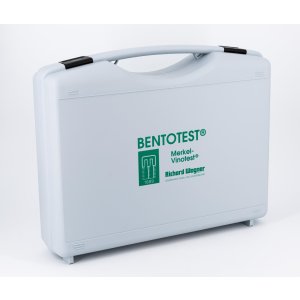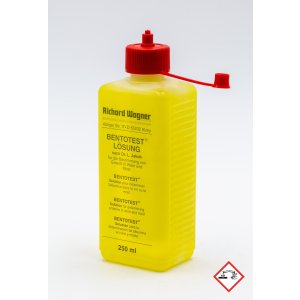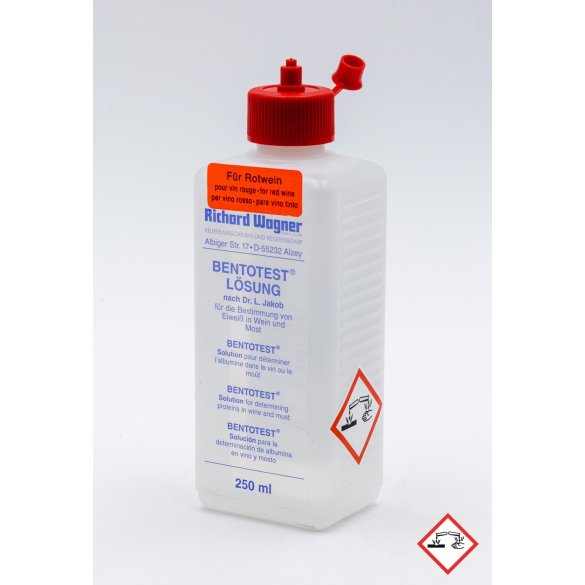Aqueous solution containing molybdenum in dilute hydrochloric acid. It is used to determine the optimal dose of bentonite for the clarification of red wine.
Measure 10 ml of clarified wine (pre-filtered) into a test tube. Then add 1 ml of Bentotest. Mix and leave at a temperature of 18-22 degrees for 5-10 minutes.
Package capacity: 250 ml.
Quick determination of the amount of bentonite needed for wine and juices
To find out whether bentonite clarification is necessary for the tested drink, the following preliminary test is carried out:
1 part of BENTOTEST® reagent is added to 10 parts of filtered wine (at room temperature!). In practice, it is easiest to start with the total amount of drink in the flask (approx. 50 cm3, ml) and add about 5 cm3, ml of BENTOTEST® reagent.
In wines requiring bentonite treatment, the drink becomes cloudy. With a little practice, the amount of bentonite needed can be deduced from the degree of turbidity. If the user has difficulty recognizing a slight turbidity with the colorless BENTOTEST® reagent, the yellow BENTOTEST® reagent may be the best choice. Any green coloration that may occur during the reaction is of no consequence. It even makes it easier to recognize a slight turbidity.
The rule of thumb is as follows:
Slight turbidity: 50 to 100 g bentonite per hectoliter of wine
Medium turbidity: 100 to 250 g bentonite per hectoliter of wine
Extreme turbidity: 250 to 400 g bentonite per hectoliter of wine
To determine the exact amount of bentonite, the clarification experiments should be carried out as follows.
Preliminary clarification experiment:
1) Pour the wine into the BENTOTEST® flask up to the O mark.
2) Measure exactly up to the O mark using a pipette.
3) Shake the bottle with the bentonite suspension (yellow label) vigorously.
4) Add the well-mixed bentonite suspension to the drink in the flask in the amount estimated in the preliminary test.
5) Close the flask by placing your thumb over it and shake for 2-3 minutes.
6) Then filter through special BENTOTEST® folding filters in an Erlenmeyer flask.
7) Add 1 part BENTOTEST® reagent to 10 parts of filtered wine.
The wine is free from protein when no cloudiness appears.
The amount of bentonite needed can be obtained most accurately by carrying out 3 clarification experiments for each wine or fruit juice with increasing amounts of bentonite and observing the amount that makes the drink protein-free. It should be emphasized that the bentonite suspension used should always come from bentonite used in wineries.
The information provided on our website is intended to provide advice to the best of our knowledge. However, its content is not legally binding.
